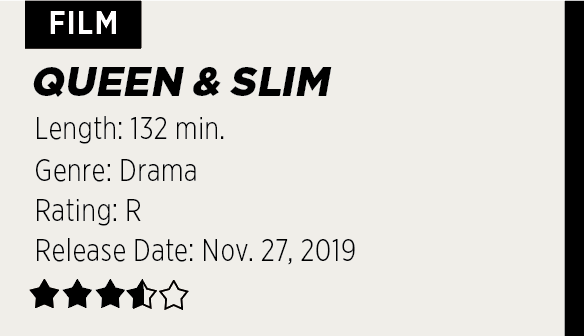REVIEW: ‘Queen & Slim’ prevails despite messy script

“Queen and Slim” opens with a Tinder date in a local diner, Queen (Jodie Turner-Smith) and Slim (Daniel Kaluuya) discussing photographs.
Slim doesn’t like taking photos of himself. He knows what he looks like. But Queen believes that pictures are something deeper, proof of one’s existence. Slim isn’t having it. “My mother and father know I’m here. That’s enough,” he responds. This is the central thematic thread of the “Queen and Slim” legacy, whether it be immortalization by celluloid or memories embedded in the minds of family.
On the way back from their date, Queen and Slim are pulled over by a police officer. The situation escalates, eventually, Slim kills the officer in self-defense, launching the rest of the movie — a “Bonnie and Clyde”-esque chase across the country as the couple attempts to escape to Cuba, bumping into strange characters along the way.
The strongest part of the film is undeniably Melina Matsoukas’ directing. Previously known for her work on Beyoncé’s “Lemonade,” she shows off a remarkable set of techniques, especially for a first-time feature film director.
Much of the film features the couple driving through America, and Matsoukas chooses to film most of this from the outside of the car — many of the shots are of Queen or Slim looking out through the window. Seeing the characters through a pane of glass is reminiscent of a museum or picture frame, again playing on this idea of legacy. Queen and Slim are being immortalized, both through the media sensationalizing their journey across the country in the film, and through metatextuality by the film itself.
Matsoukas also works well with cinematographer Tat Radcliffe to craft some beautiful images. There is a lot of cool turquoise and deep blues, as well as an overt interest in black features. There are multiple instances of presenting dialogue as voiceover while the camera observes Queen or Slim, content in capturing their quiet emotionality instead of the actual machinations of their speech.
Kaluuya as Slim and Turner-Smith as Queen both give good performances throughout the film, however they don’t do well together. Especially in the beginning, they lack the chemistry to properly sell their relationship, causing the film to drag in the first half. This could partly be attributed to some of the dialogue — in fact, the script, written by Lena Waithe, seems to be the film’s biggest flaw.
Waithe attempts to weave social commentary throughout the narrative, playing on imagery familiar to the viewers from media coverage of the Black Lives Matter movement. Most of it is quite clumsy, trying to be provocative but too self-conscious to offer up any new or interesting ideas.
One sequence in particular — a protest-turned-riot in support of Queen and Slim which is intercut with them having sex for the first time — is comedic in how completely it fumbles the theme Waithe sets up. There are also a few scenes that creep up on “Atlanta”-esque surrealism but don’t stick the landing and just come across as awkward.
However, the ending is beautiful. Queen and Slim make a final stand on an airport runway — cops on one side, a plane on the other — escape within reach. Everything comes together — their immortalization, their struggle, their lives, their death.
We don’t end lingering on the fate of Queen and Slim. Instead, we see a picture they took earlier in the film becoming a symbol of their struggle and something bigger than them, a rallying point for change. It is, in effect, their legacy.


